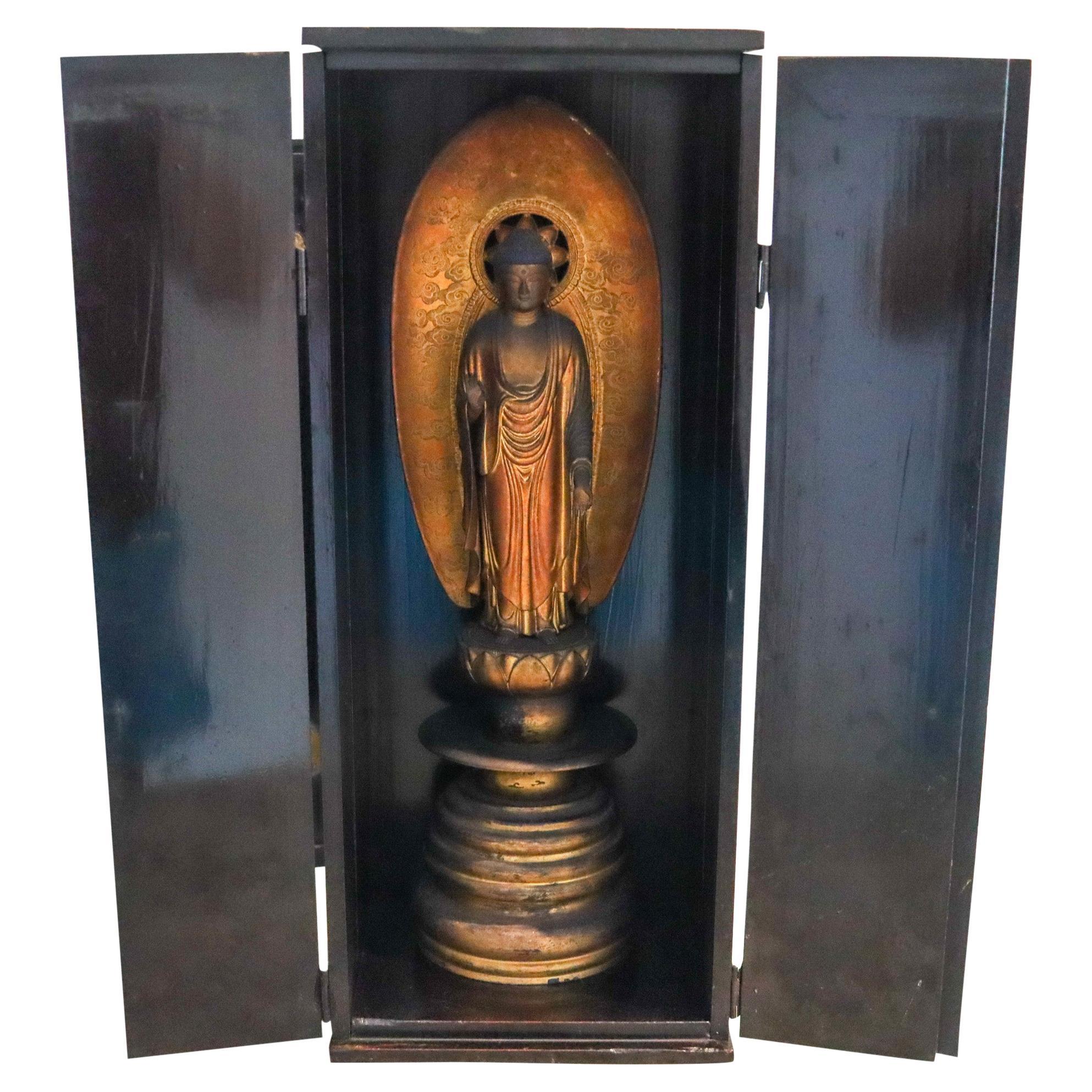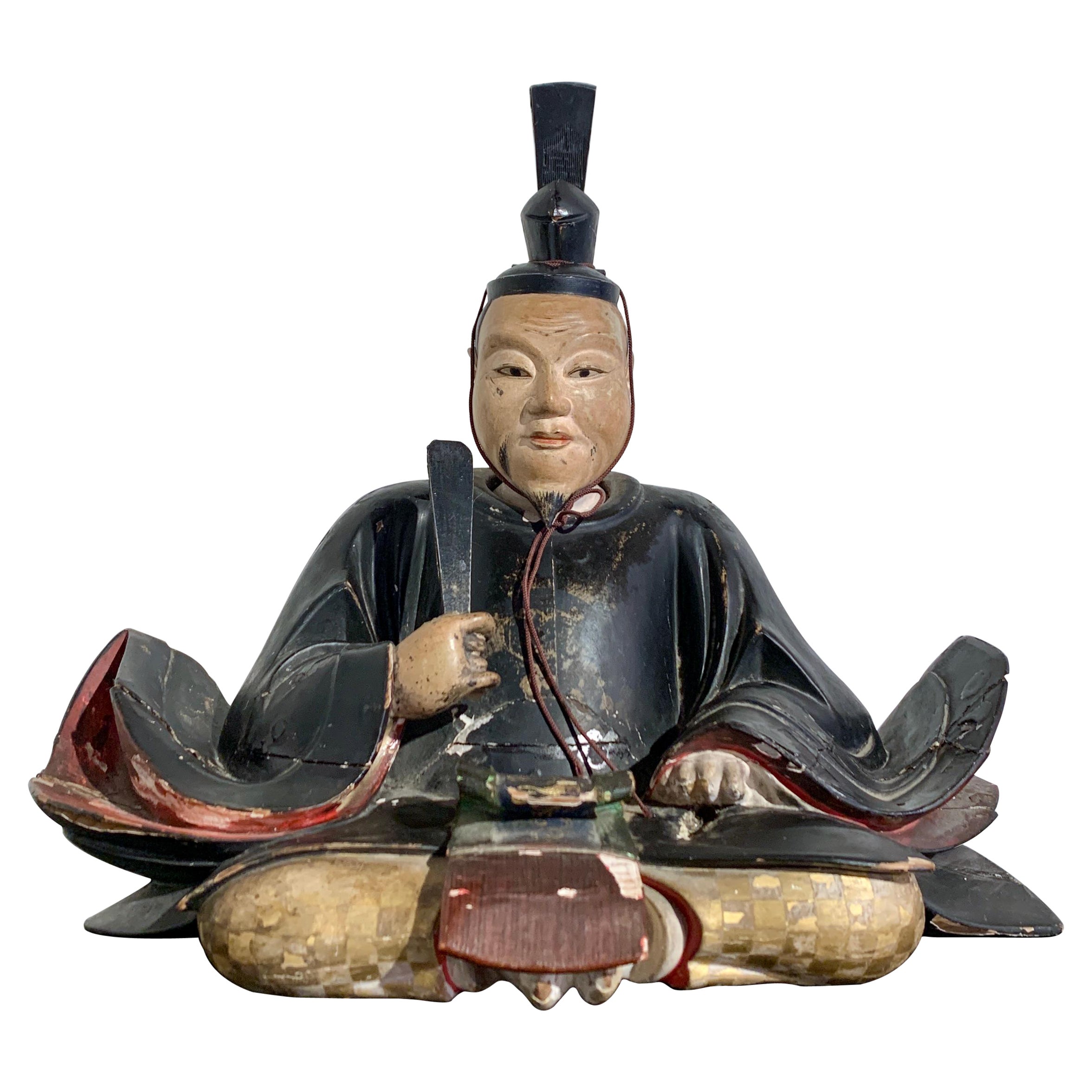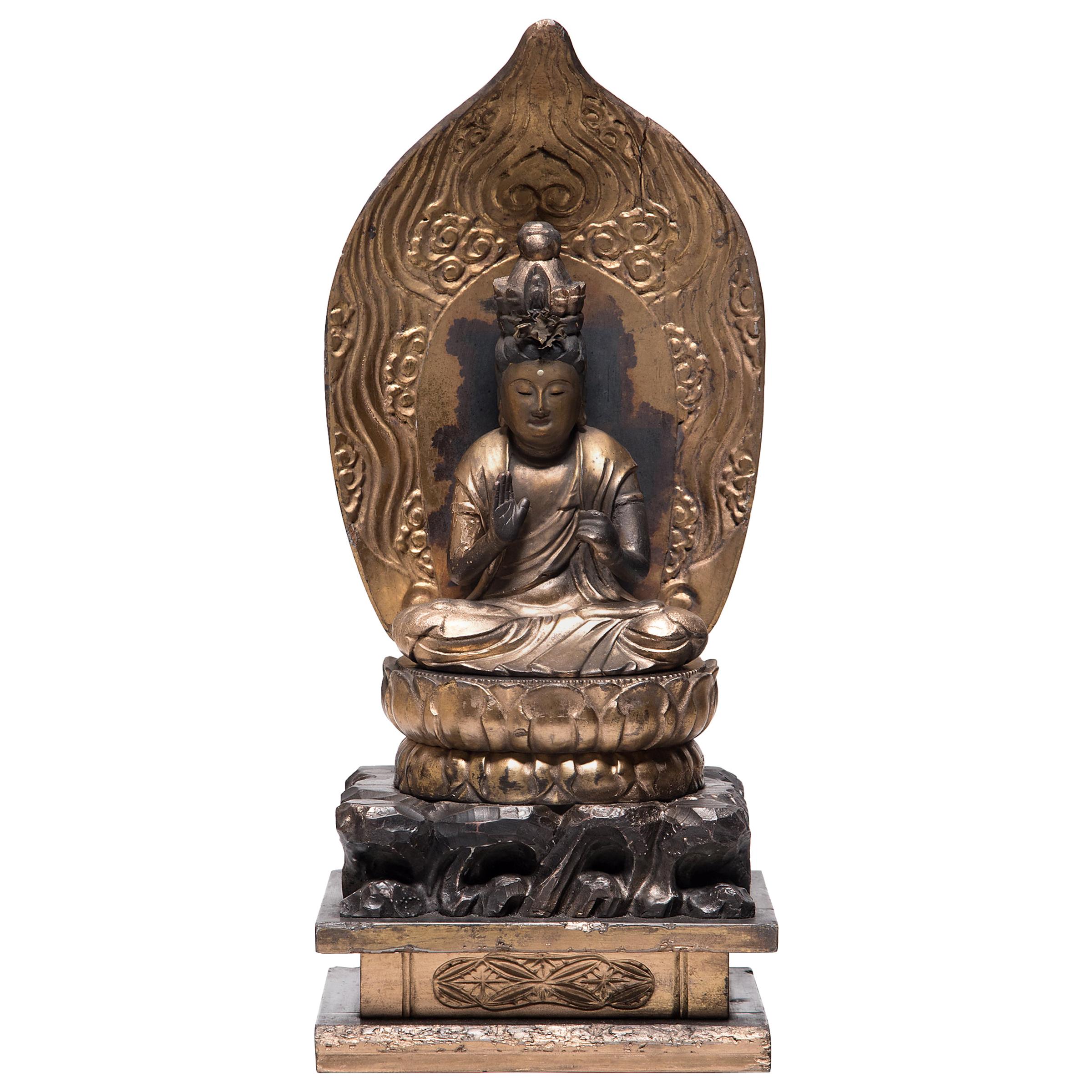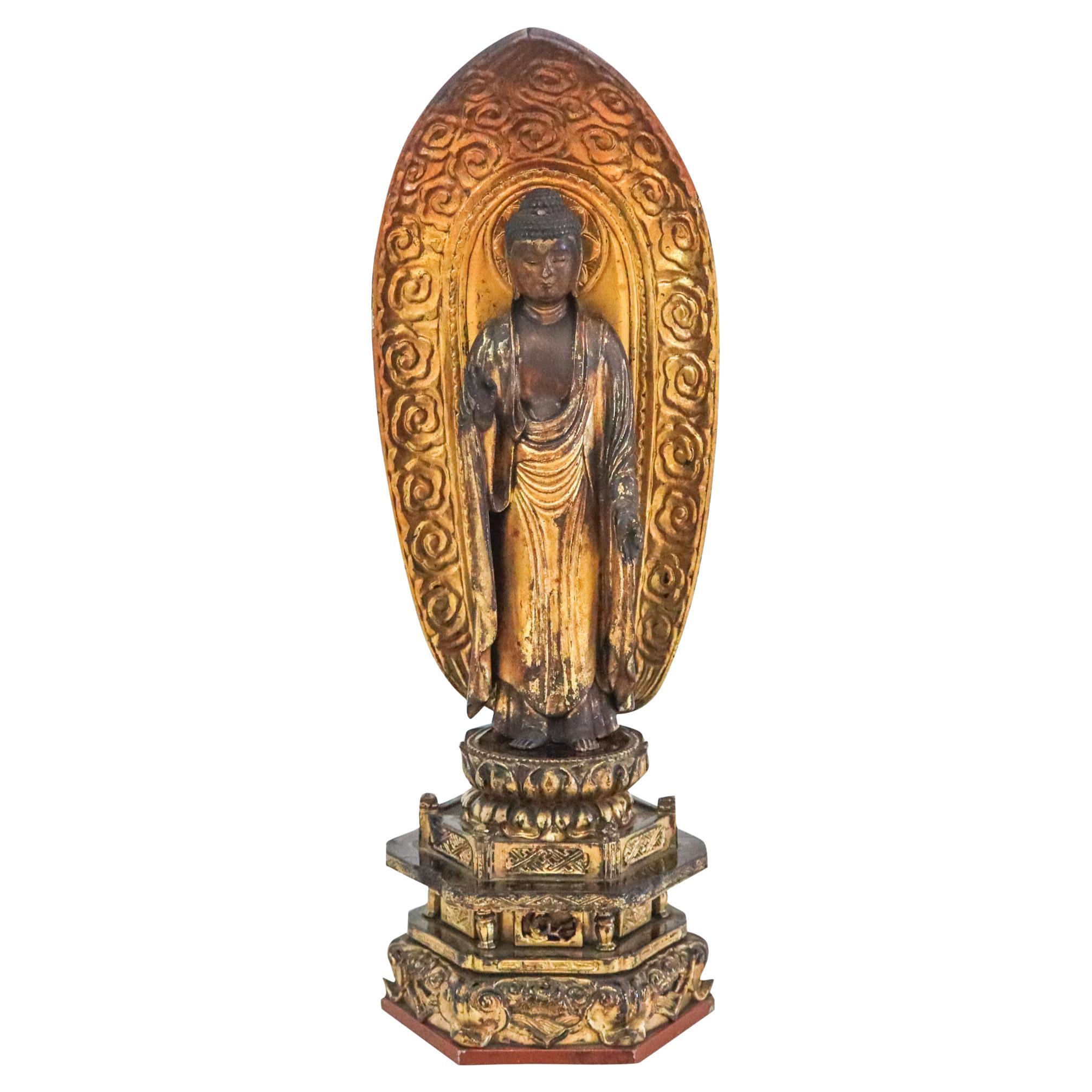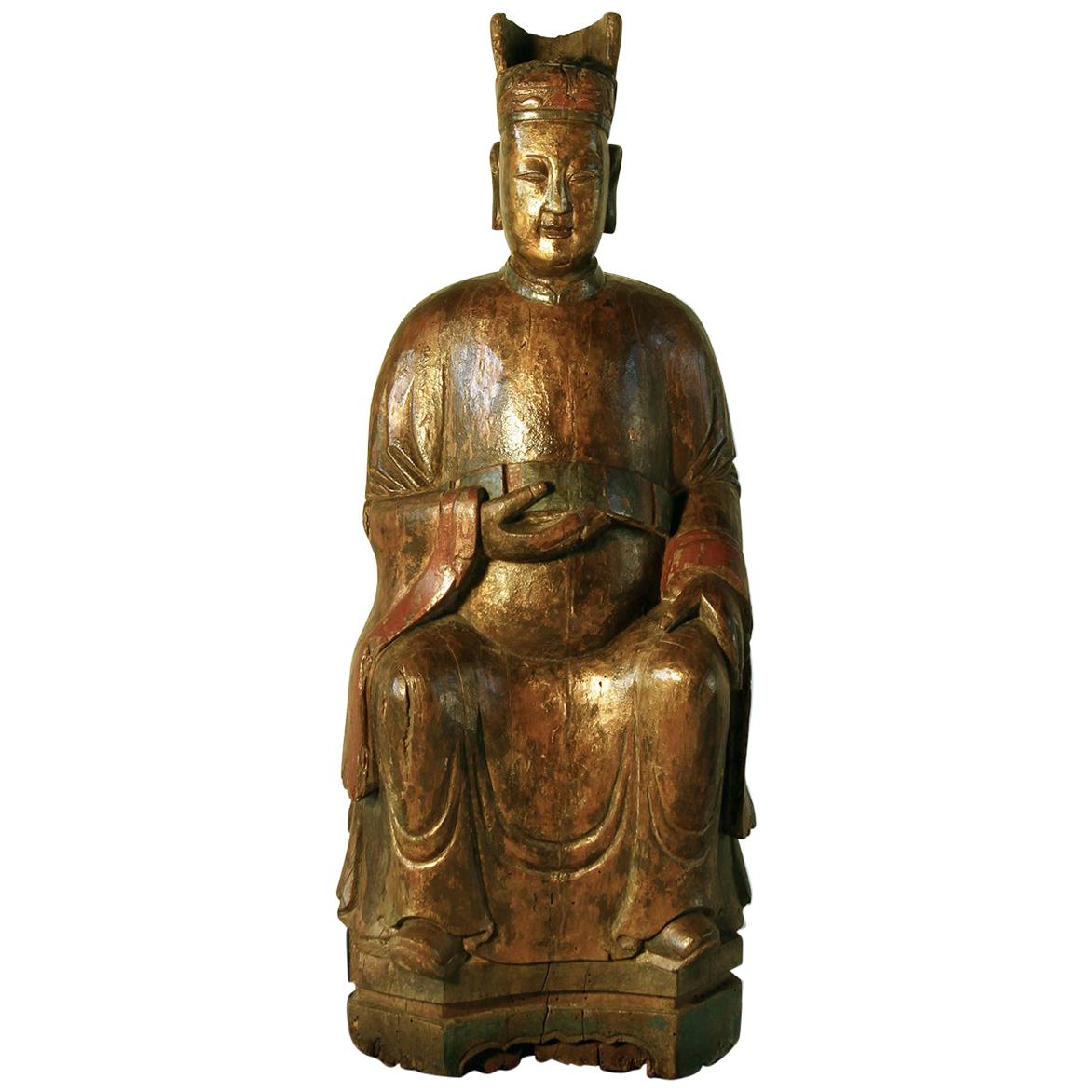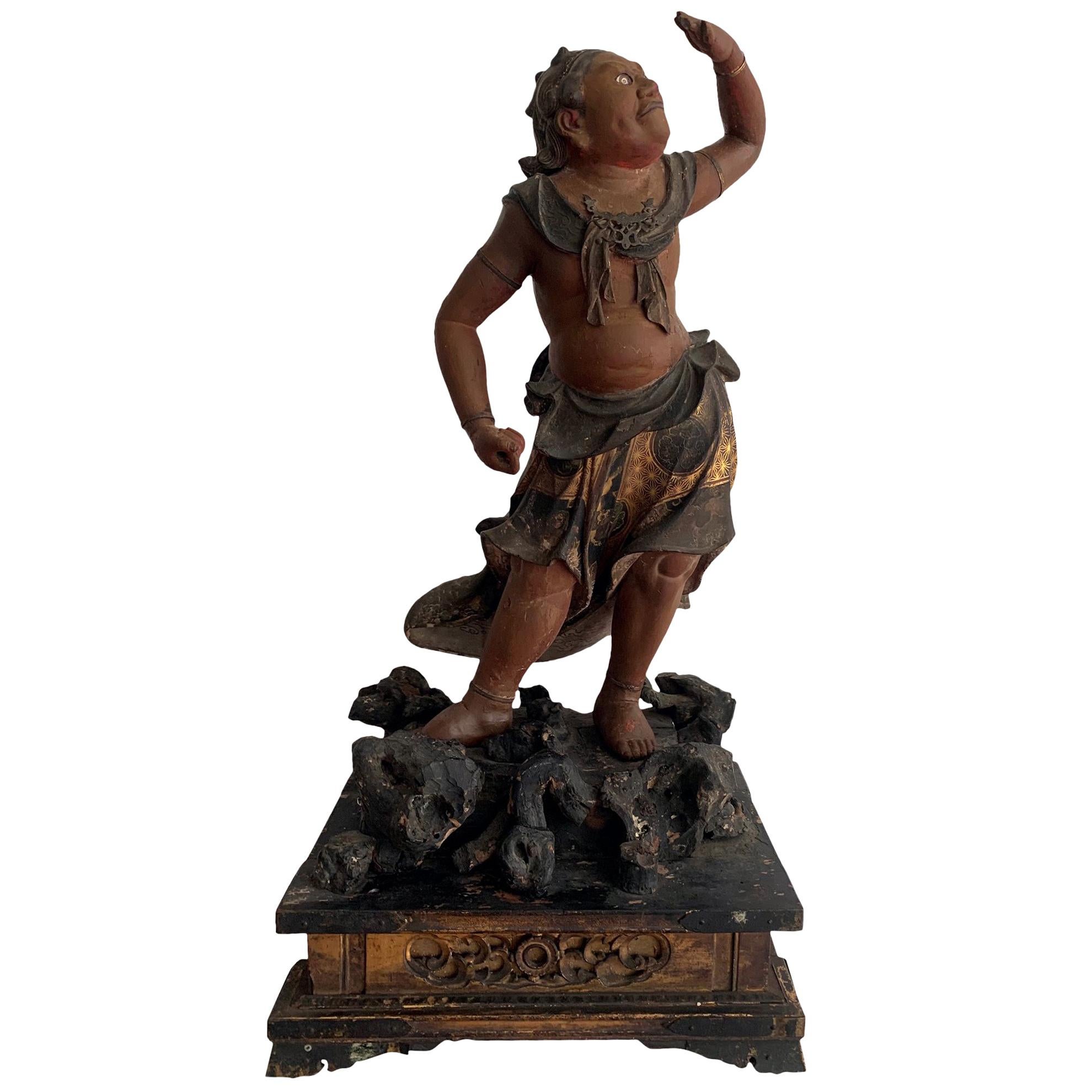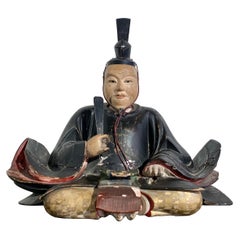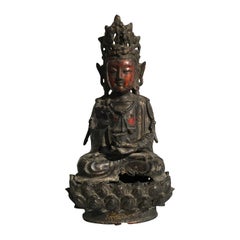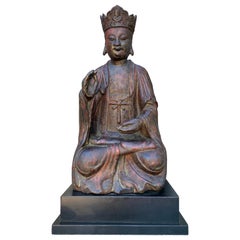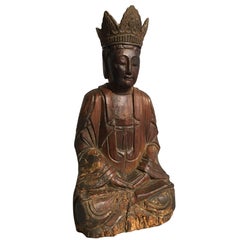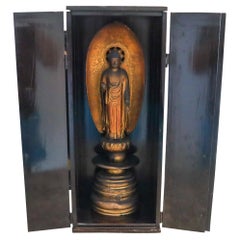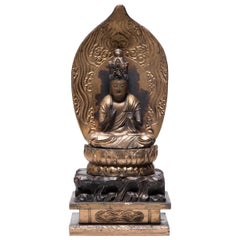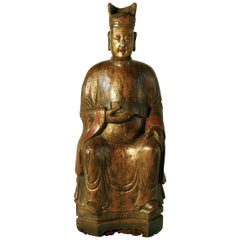Items Similar to Japanese Lacquered Wood Sho Kannon, Momoyama/Edo Period, 17th Century, Japan
Want more images or videos?
Request additional images or videos from the seller
1 of 14
Japanese Lacquered Wood Sho Kannon, Momoyama/Edo Period, 17th Century, Japan
$17,500
£13,379.68
€15,410.69
CA$24,522.87
A$27,377.47
CHF 14,345.38
MX$335,127.15
NOK 182,186.52
SEK 171,778.76
DKK 115,011.57
Shipping
Retrieving quote...The 1stDibs Promise:
Authenticity Guarantee,
Money-Back Guarantee,
24-Hour Cancellation
About the Item
A tall and impressive Japanese carved and black lacquered figure of Sho Kannon Bosatsu, Momoyama or Edo Period, mid 17th century, on a later mid 19th century carved, painted, and gilt wood lotus pedestal base.
The tall and dignified image depicts Sho Kannon Bosatsu, Avalokiteshvara, the Bodhisattva of Compassion. The qualifier "Sho" can be translated as "sacred", and refers to Kannon's primary form, the form upon which all other forms of Kannon are based. The image carved from a single piece of cypress wood in the ichiboku-zukuri technique, and covered in a black lacquer.
Here, Kannon stands regally upon a later 19th century Edo Period gilt wood lotus pedestal base. Kannon is dressed in heavy, loose fitting robes that drape elegantly around his robust body, arms covered by long, flowing sleeves. A metal necklace with hanging pendants decorates his exposed chest. He holds one hand at heart level, thumb touching forefinger in jnana mudra, the gesture of wisdom. The other hand clasped, and would originally have held a lotus stem, now holding a stylized willow leaf.
Kannon's face is open and welcoming, a soft smile playing softly on his lips. He looks out into the world from large, almond shaped eyes. His long hair styled in tresses and tied in a high chignon, all held in place by a large diadem with a small image of Amida Nyorai in the center.
Kannon stands upon an elaborate upward facing lotus pedestal of polychrome green and blue with gilt highlights. The lotus is supported by a tiered gilt wood pedestal with carved lotus designs.
Kannon is the Bodhisattva of Compassion. Known as Avalokiteshvara in Sanskrit, and Guanyin in Chinese, Kannon is said to alleviate suffering. In the form of Sho Kannon, he is savior to beings trapped in the hell realms.
Provenance:
Private California and Texas Collection
Samuk, San Francisco, 1990
- Dimensions:Height: 34 in (86.36 cm)Width: 12.5 in (31.75 cm)Depth: 10.25 in (26.04 cm)
- Style:Edo (Of the Period)
- Materials and Techniques:
- Place of Origin:
- Period:Mid-17th Century
- Date of Manufacture:mid 17th century
- Condition:Reupholstered. Additions or alterations made to the original: The figure married to an early 19th century base. The branch in the hand a later replacement. Repaired: One finger repaired. Wear consistent with age and use. Minor losses. Minor structural damages. Minor fading. The figure showing signs of heavy wear to the lacquer. The wood with losses and old worm damage. One hanging ornament missing. The base of a later date.
- Seller Location:Austin, TX
- Reference Number:1stDibs: LU894739985452
About the Seller
5.0
Platinum Seller
Premium sellers with a 4.7+ rating and 24-hour response times
Established in 2001
1stDibs seller since 2010
345 sales on 1stDibs
Typical response time: <1 hour
- ShippingRetrieving quote...Shipping from: Austin, TX
- Return Policy
Authenticity Guarantee
In the unlikely event there’s an issue with an item’s authenticity, contact us within 1 year for a full refund. DetailsMoney-Back Guarantee
If your item is not as described, is damaged in transit, or does not arrive, contact us within 7 days for a full refund. Details24-Hour Cancellation
You have a 24-hour grace period in which to reconsider your purchase, with no questions asked.Vetted Professional Sellers
Our world-class sellers must adhere to strict standards for service and quality, maintaining the integrity of our listings.Price-Match Guarantee
If you find that a seller listed the same item for a lower price elsewhere, we’ll match it.Trusted Global Delivery
Our best-in-class carrier network provides specialized shipping options worldwide, including custom delivery.More From This Seller
View AllJapanese Carved and Lacquered Wood Shogun, Edo Period, 19th Century, Japan
Located in Austin, TX
An unusual Japanese carved wood, lacquer, and gilt decorated portrait sculpture of a shogun, Edo Period, early 19th century, Japan.
The unidentified shogun (possibly Tokugawa Iey...
Category
Antique Mid-19th Century Japanese Edo Sculptures and Carvings
Materials
Wood, Lacquer
Chinese Ming Dynasty Lacquered and Gilt Bronze Bodhisattva, 17th Century
Located in Austin, TX
Chinese late Ming dynasty bronze figure of the Bodhisattva Avalokiteshvara, also known as Guanyin (Quan Yin, Kwan Yin, Kuan Yin), 17th century, China
The figure well cast in two ...
Category
Antique Mid-17th Century Chinese Ming Sculptures and Carvings
Materials
Bronze
Chinese Qing Dynasty Lacquered Wood Guanyin, 18th Century, Southern China
Located in Austin, TX
A Chinese early Qing Dynasty carved and lacquered wood figure of Guanyin, Southern China, 17th/18th century.
Guanyin, the Bodhisattva of Compassion and Mercy, is portrayed seated in dhyanasana, one hand raised in viktara mudra, the gesture of teaching and discourse.
The great bodhisattva is dressed in heavy, loose robes tied at the chest, with a mantle draped over his shoulders. He looks serenely outwards from heavily lidded eyes. Guanyin's face carved beautifully with somewhat feminine features. A large five pointed crown sits upon his head. The larger leaves of the crown carved with indistinct images of the Buddha.
The statue was originally fully lacquered in the deep red gilt lacquer typical of Southern Chinese Buddhist sculpture...
Category
Antique Early 18th Century Chinese Qing Sculptures and Carvings
Materials
Wood
Chinese Carved Wood Bodhisattva Guanyin, Late Ming Dynasty, 17th Century
Located in Austin, TX
An attractive carved wood figure of the Bodhisattva Avalokiteshvara, known as Guanyin in China, late Ming Dynasty, early 17th century, China.
Guanyi...
Category
Antique Early 17th Century Chinese Ming Sculptures and Carvings
Materials
Gesso, Wood
Japanese Giltwood Medicine Buddha, Yakushi Nyorai, Muromachi Period 16th Century
Located in Austin, TX
A striking Japanese late Muromachi Period (1333-1573) lacquered and giltwood figure of Yakushi Nyorai, the Medicine Buddha, seated upon an elaborate car...
Category
Antique 16th Century Japanese Edo Sculptures and Carvings
Materials
Rock Crystal
Chinese Carved Boxwood Figure of Guanyin, Mid-Qing Dynasty
Located in Austin, TX
A sublime Chinese carved boxwood figure of the Bodhisattva of Compassion, Avalokiteshvara, called Guanyin in Chinese, mid-Qing dynasty.
The an...
Category
Antique Late 18th Century Chinese Qing Sculptures and Carvings
Materials
Boxwood
You May Also Like
JAPAN 1810 Edo Period Large Butsudan Home Altar With Amida Nyorai In Wood
Located in Miami, FL
Large butsudan home altar with Amida Nyorai figure Edo Period (1600-1868)
This is a beautiful Japanese wooden statue of standing Amida Nyorai Buddha, from the Edo period (1600-1868)...
Category
Antique 1810s Japanese Edo Sculptures and Carvings
Materials
Gold, Brass
Japanese Gilt Seated Kannon Figure, circa 1850
Located in Chicago, IL
Intricately carved and finished with gilt black lacquer, this seated figure depicts the bodhisattva Guanyin, known in Japanese Buddhism as Kannon. Described as the "Buddha of Infinite Compassion," Kannon is the embodiment of mercy and makes himself available to all who call upon him with all their mind.
Kannon is depicted here seated in diamond position upon a double lotus plinth, set above a stepped base. He is dressed in gracefully draped robes and wears a tall crown bearing a minuscule figure of Amida, the Buddha of Infinite Light. He has a serene expression of calm and holds his right hand in the abhaya mudra, a gesture of comfort, blessing, and protection. Backed by a magnificent leaf-form nimbus, this Kannon figure...
Category
Antique Mid-19th Century Japanese Edo Sculptures and Carvings
Materials
Wood, Lacquer
JAPAN Edo Period 1750 Amida Nyorai Buddha Sculpture In Gilt Carved Wood
Located in Miami, FL
An Amida Nyorai Sculpture In Gilt Carved Wood from the Edo Period.
This is a superbly refined carved wooden figure of Amida Nyorai (Amitabha), the Buddha of Infinite Light, with fab...
Category
Antique 1750s Japanese Edo Sculptures and Carvings
Materials
Gold, Bronze, Gold Leaf
18th Century Chinese Sculpture of a Dignitary in Carved and Lacquered Hardwood
Located in Brescia, IT
Big hardwood figure of a dignitary lacquered in original patina. Signs of age-related wear on the base, but all of excellent quality, China, 18th century.
Category
Antique 18th Century Chinese Qing Sculptures and Carvings
Materials
Hardwood
Japanese Lacquered and Gilt Wood Buddhism Statue from Edo Period
Located in Atlanta, GA
An exceptional and wood statue of Buddhism Guardian Seitaka Doji from Japan circa Edo period (1603-1868), likely the earlier part of 17th century. One of two chief attendants of Fudou Myouou (the other being Kongara Doji), the name of Seitaka Doji is a transliteration of Sanskrit "Cetaka", meaning servant, slave, and he is said to personify expedient action. He is most commonly found on the right side of Fudou, together with Kongara Doji on the left, forming the Immovable triad, Fudou Sanzon, the terror of evil doers. Seitaka largely adheres to the iconography of a wrathful youth with fleshy body and face, skin in the color of a red lotus, has his hair tied in five knots, and holds a vajra in his left hand and a vajra-club in his right hand, but the actual artistic representations of him in Japan do...
Category
Antique 17th Century Japanese Japonisme Sculptures and Carvings
Materials
Metal
Antique Japanese Carved Village Buddha Enku Style
Located in Atlanta, GA
A carved wood buddha with lacquered surface in the style of Erku (1632–1695), a monk from Edo period who was famous for hand-carving Buddha statues in a primitive style. From a single wood block of what appears to be cedar, the standing buddha was carved in an unpolished manner with exposed knife strokes that effectively depicted a subtly smiling face and the folding of the cascading robes. The rustic style is full of Mingei charm being a great example of Japanese Buddhism...
Category
Antique 18th Century Japanese Edo Sculptures and Carvings
Materials
Wood
More Ways To Browse
Antique Wood Levels
Japanese Mid Century Design
Regal Mid Century
Sculpture Wood 17th Century
Black Japanese Chest
Antique Cypress
Japanese Metal Sculpture
Metal Dress Forms
Antique Cypress Furniture
Polychrome Wood Carving
Dress Form Mid Century
17th Century Carved Wood Sculpture
Hanging Wood Carving
Antique Traps
Antique Blue Willow
Antique Sacred Heart
Black Lacquered Wood Pedestal
19th Century Japanese Chest
